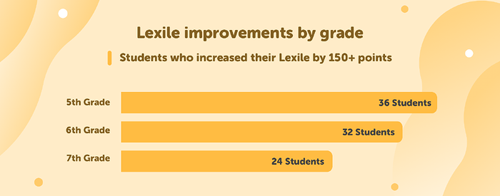Two Schools Make Big Strides in Reading and Student Outcomes
For Joy James Elementary School in Texas and Mitchell County Middle School in Georgia, improving reading outcomes after pandemic learning loss became an essential goal. Leaders at both schools recognized independent reading's crucial impact on students' reading comprehension and fluency.

For Joy James Elementary School in Texas and Mitchell County Middle School in Georgia, improving reading outcomes after pandemic learning loss became an essential goal for the 2021–2022 school year. Leaders at both schools recognized independent reading's crucial impact on students' reading comprehension and fluency, not to mention its trickle-down effect on all other academic areas. They wanted to encourage students to develop healthy reading habits that last.
Gamified Reading Logs with Built-in Motivation
Located in Fort Worth, Texas, Joy James is part of Castleberry Independent School District, which serves more than 3,600 students. Following “Leader in Me” educational principles, school leaders challenged students to read 2,000 minutes during the 2021–2022 school year. To track their independent reading, students used Beanstack, a software and app that Castleberry ISD recently introduced to the district.
Beanstack simplified logging and tracking students’ reading minutes, and its gamification features like badges, streaks, and friends helped motivate even the most reluctant readers. Teacher Librarian Neznaika Senerchia was especially impressed by how Beanstack sparked student conversations about reading. “I have never had so many meaningful conversations with students about what and how much they are reading,” she said. “They love to tell me and others how many minutes they've logged and what books they've been reading.”
Increased Reading Test Scores by More Than 60%
The gains at Joy James were remarkable. Statewide, student scores in 2022 were inching back up after the pandemic. At Joy James, however, average student reading scores increased by 29 points from 2021 to 2022—20 points higher than the state’s average gains for grades 3–8—for a growth of 62%. First graders’ reading scores jumped by 36 points, from a score of 46 to 82; second grade scores leapt 31 points, from 39 to 70. Third grade reading scores saw an astounding 44-point surge, from 33 to 77. And it wasn’t just reading scores that improved at Joy James: Average math scores for grades 3–5 rose 23 points from 2021 to 2022, for 47% growth.
 |
Principal Leigh Ann Turner summed their year up this way: "It's amazing what this tool helped us accomplish with student goal setting and tracking. Reading motivation skyrocketed for ALL students last year. Beanstack helped us cultivate excitement and the love of learning through the use of rich literature throughout our campus.”
Intrinsic Rewards and Small Incentives
Like many other schools across the country, fifth to seventh grade students in Mitchell County, Georgia, were falling behind in reading comprehension and fluency. In their School Improvement Plan, their principal set a goal to improve student reading levels by 3% during the 2021–2022 school year.
Media specialist Jaycie Holland worked to build engagement with reading and logging in Beanstack from the beginning. She prepped English Language Arts teachers so they could support students logging independent reading time during class. Holland deemed every Friday “Beanstack Day,” and reminded students to log their reading during the school’s morning announcements. While the gamification features in Beanstack made reading its own intrinsic reward, prizes—even small ones—helped build up kids’ excitement and motivation. Holland created incentives for achieving both daily reading and long-term reading goals. Students selected small rewards from a treasure chest for logging a certain amount of reading and could win surprise prizes simply for logging on a random day.
Improved Reading Comprehension by 10%
In just the first four months of their school year, Mitchell County Middle School students showed widespread reading engagement through Beanstack, with more than 70% of students logging reading between August and December. To gauge reading improvement, Mitchell County’s school leaders used individual assessments from NWEA’s MAP Suite and an aggregate Lexile value for the school. The school’s total Lexile value increased nearly 10% from the fall to the winter, from 195,650L to 214,445L. And when they looked at individual Lexile scores, about one-third of their students improved by more than 150L.
 |
Joy James Elementary School and Mitchell County Middle School are great examples of how a district- or library-funded digital resource can improve reading comprehension and student outcomes while keeping reading fun. Visit the Beanstack blog to read complete case studies for both Joy James and Mitchell County.
To learn more about how your school can use Beanstack to build a culture of reading, visit beanstack.com.
SPONSORED BY
 |
RELATED
The job outlook in 2030: Librarians will be in demand
The job outlook in 2030: Librarians will be in demand
ALREADY A SUBSCRIBER? LOG IN
We are currently offering this content for free. Sign up now to activate your personal profile, where you can save articles for future viewing






Add Comment :-
Be the first reader to comment.
Comment Policy:
Comment should not be empty !!!